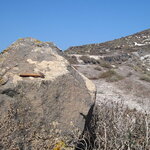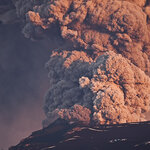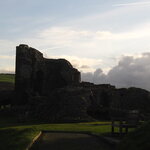Geology

One of our popular topics last year was earthquakes. That makes sense, with the earthquake in Japan. It's not like there was some greater instance of earthquakes but if you are a Doomsday fearmonger, any event is a good event; that means anti-science activists determined to send us back to the 13th century looked for ways to make earthquakes result from fracking.
If you dispute that, you get meaningless gibberish responses like 'you can't prove the earthquakes did not come from fracking', which is true, in the same way you can't prove I am not the disembodied brain of Adolf Hitler…

My friend has written a paper on Pantelleria (which I am a co-author of), and I thought it was a good opportunity to discuss some of the techniques we can use to reconstruct a volcano's magma chamber using the petrology (chemistry and texture of the crystals and glass) of the rocks erupted at the surface.
I've written before about Pantelleria, and now my friend David Neave has published a paper on the research we did there. I should point out the most of the credit belongs to David as he did most of the work, but I thought I should write a bit about it here.
The bulk of this paper uses…

The deadliest mass extinction that we know of, 252 million years ago at the end of the Permian period, took a long time to kill most of Earth's life, and it killed in stages. It wasn't superior to sudden extinctions just because it was gradual.
By the end of the Permian period, Earth was almost a lifeless planet. Around 90 percent of all living species disappeared then, in what scientists have called "The Great Dying." Chemical evidence buried in rocks formed during this major extinction can tell science part of what happened.Thomas J. Algeo, professor of geology at the University of…

A new study in Nature shows that Santorini may have reactivated roughly a century before the Minoan "super-eruption", a lot quicker than had previously been thought. How is it possible to time this awakening?
I have written on here before about magma chambers, and how people initially thought that the chambers of the largest eruptions grew through the slow, incremental process of fractionation.
More recently, the idea has grown of magma mushes, of partially solidified magma chambers ready to be rejuvenated and erupted. But just how long before an eruption, especially of…
I think most people - certainly myself - get that grim "what, another one?" feeling when you first hear news that there has been a big earthquake.
But is it justified? In other words, have we recently been experiencing an increased rate of earthquakes? This from Beroza (2012),
For a nearly 40-y period after the February of 1965 M 8.7 Rat Islands, Alaska earthquake, the world did not experience a single great earthquake; however, in the 7 y since late December of 2004, there have been a barrage of five great earthquakes. These earthquakes include the 2004 M 9.1 Sumatra, Indonesia earthquake;…

Welcome to the world's slowest clock.
The 'argon-argon clock' works by measuring the ratio of the amount of radioactive potassium in a sample of rock to the amount of its decay product, argon. As scientists already know the half-life of argon's radioactive decay - 1.25 billion years - it can be used to date rocks back to the time of the formation of the Earth, some 4.5 billion years ago. The older a rock is, the more potassium has decayed and the more argon is found in the rock.
New research has been able to improve the calibration of the 'argon-argon clock' and that could mean up to a 1.2…

For the 41st Accretionary Wedge Ron Schott asked for "the most memorable or significant geological event that you've directly experienced." I had to think long and hard about this, because I haven't been lucky enough to witness anything truly exciting first hand. True, I once felt my bed shake in a hostel in Chile during a rather small earthquake, but that's hardly a significant event. The day Eyjafjallajökull erupted we were supposed to be flying back from a field trip, but the story of a 32 hour bus journey from the south of Spain isn't particularly interesting. I…
How old is the water in your drinking glass? What about the ice cubes floating in it? Any answer is bound to make reference to the water cycle (evaporate, rain, repeat). Still, for most practical purposes, water is both eternal and constantly replenished.
But when water flows underground or freezes into glacial ice, a clock starts ticking from the moment it loses contact with the air. In order to read the time, scientists must trap and count almost infinitesimally small quantities of the radioactive isotope krypton 81. Physicist Zheng-Tian Lu and his team at the U.S. Department of Energy’s…

As I have a long train journey and not much to do, I can use it to write about this recent open access paper on Eyjafjallajökull written by a couple of my colleagues in the lab. As it is open access you can go and read it for yourself if you wish, but I thought I would first explain a few of the key concepts discussed in the paper.
First, a quick reminder on the eruption itself. The timings of the various eruptive phases are important, as the researchers were looking not just at the eruption as a whole, but on how the magma changed during the eruption.
For 15 years prior to the eruption,…

There isn't really much geologically significant about this photo, other than that the castle is Made of stone. However, I wanted to finish this week of photos instigated by Evelyn in Wales, and earlier today I was in Aberystwyth and I snapped this photo.
This week has been fun, looking through my photos has brought back quite a few memories. I will get back to science soon, I have a post on Eyjafjallajörkull already lined up.
Earlier photos: